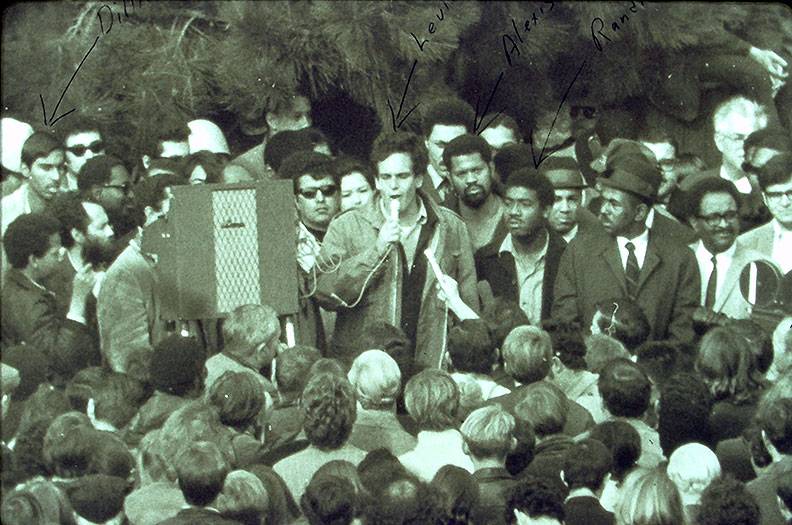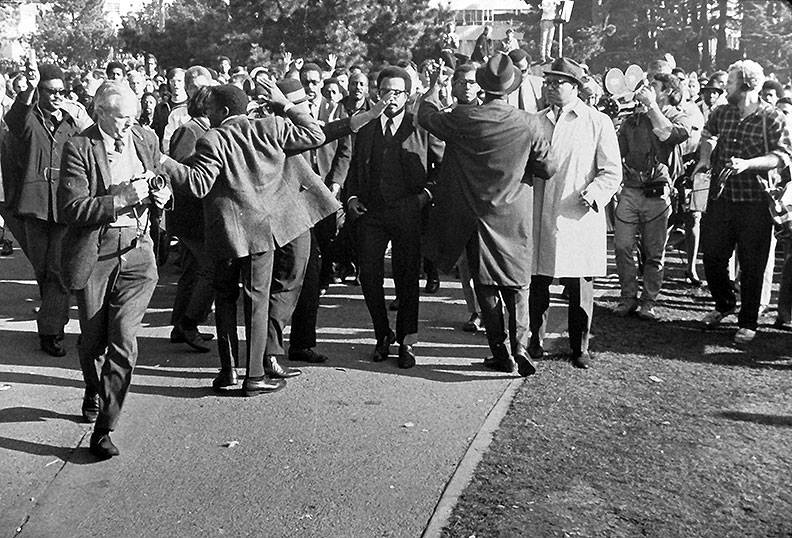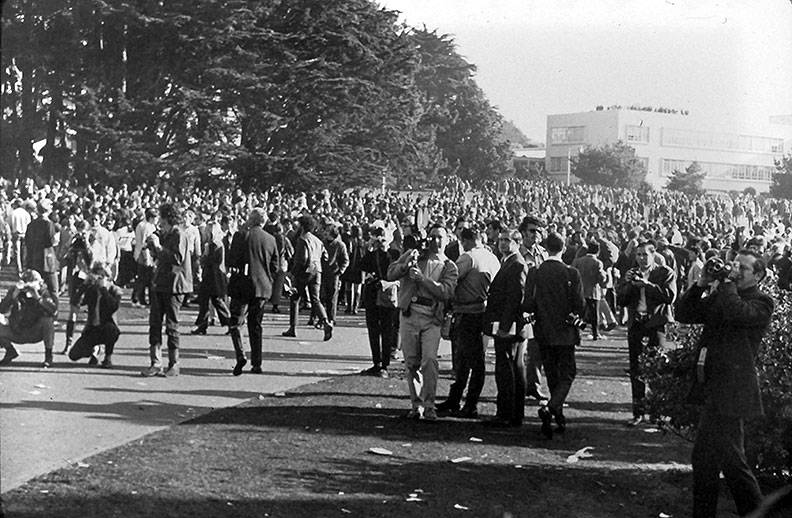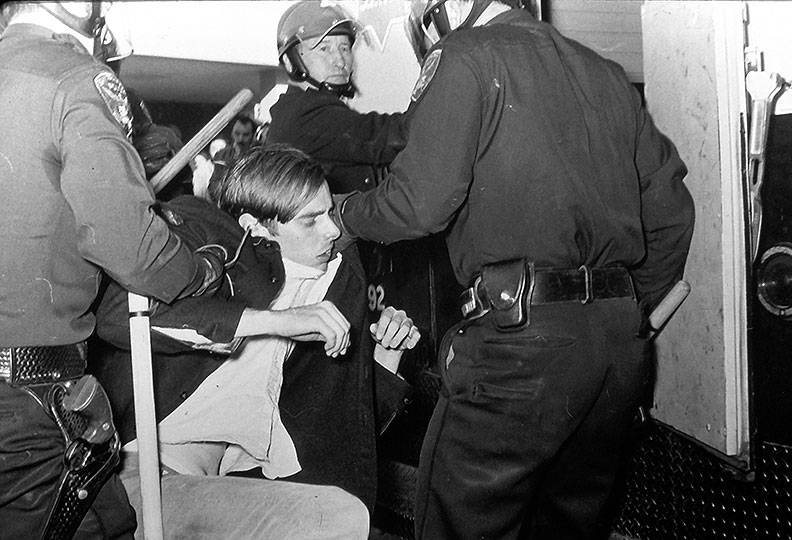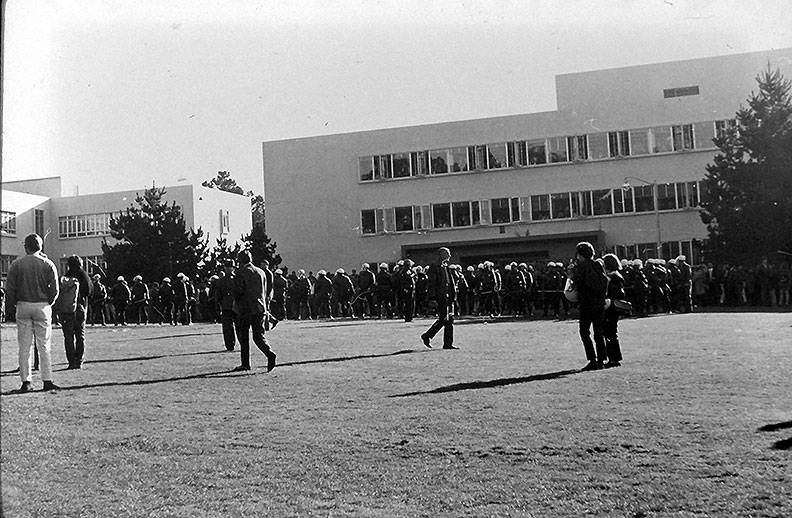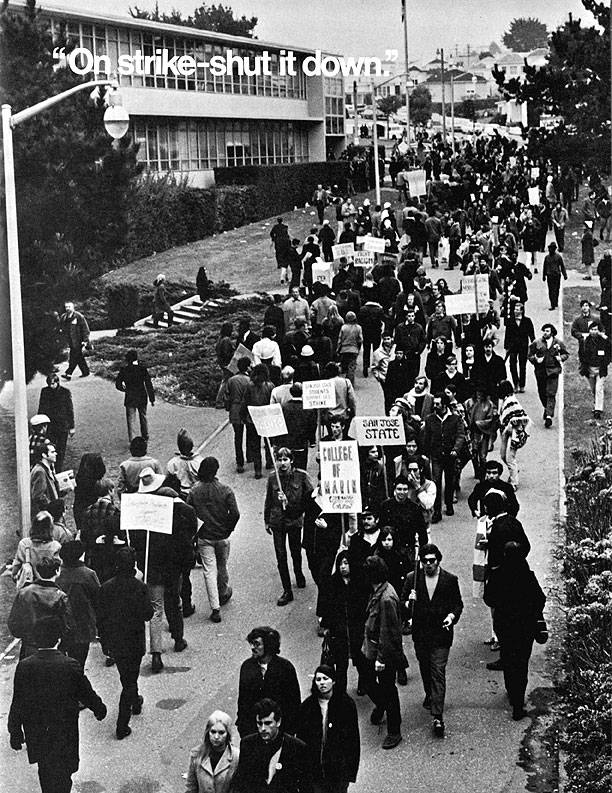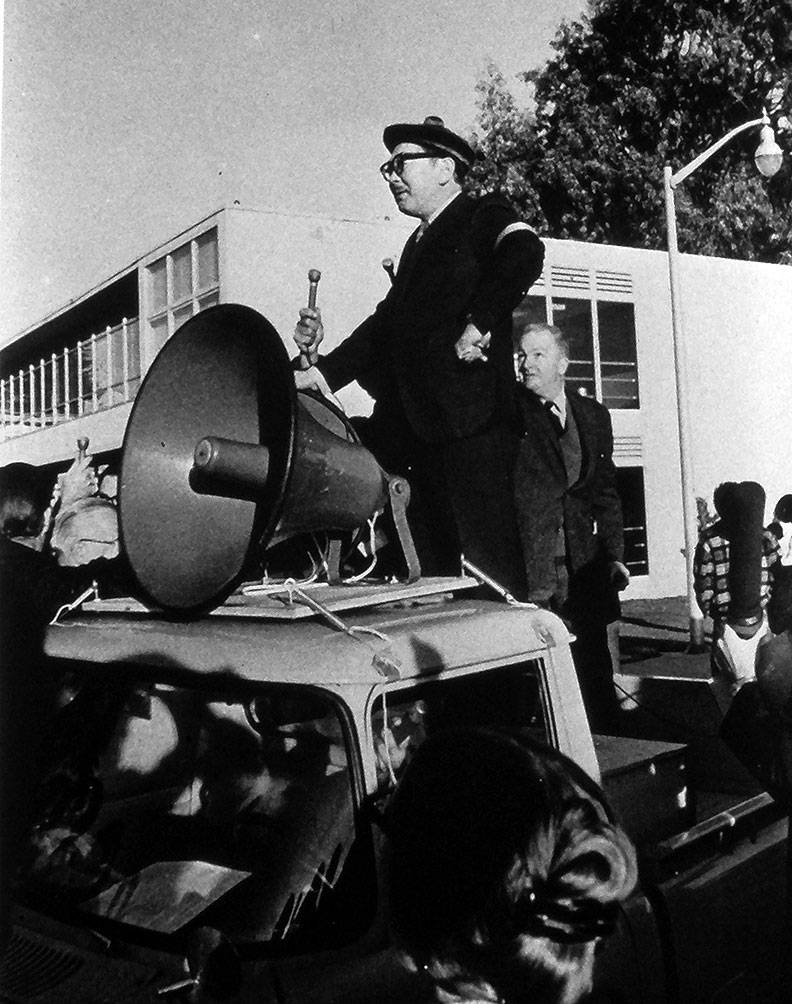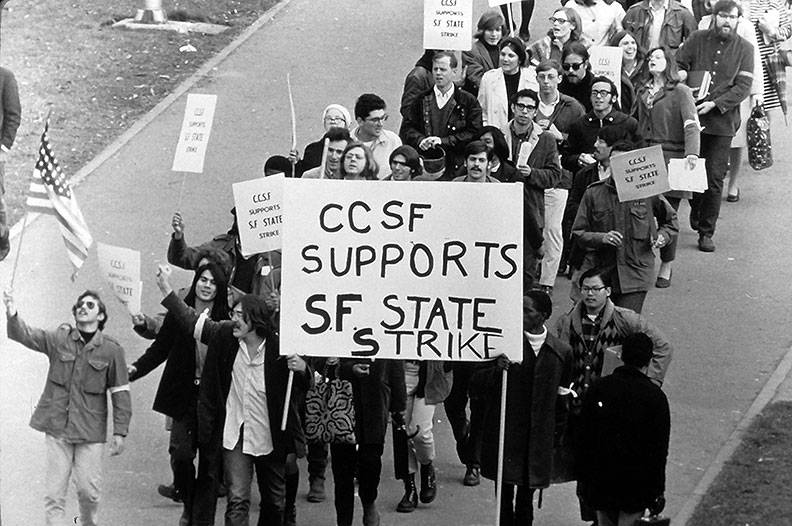On Strike! We're Gonna Shut it Down
The 1968-69 San Francisco State Strike
"I was there..."
by Margaret Leahy
What follows is not and cannot be comprehensive; rather, it is the Strike viewed from the perspective of one young San Francisco woman as she journeyed from passive observer to a political activist. Within the context of these struggles, the San Francisco State College (“State”) student community was bringing the same issues to a campus where their struggles culminated in the longest student strike in the history of the United States—four and one-half months, from November 1968 to April 1969. That strike and my perceptions as to what led up to it, what happened during and after it and what lessons it might have for today are the topic of this article.
John Levin speaking during San Francisco State College Strike, Fall 1968.
Photo: Tim Drescher
As a second generation San Franciscan, I am a product of my city’s history. The City I grew up in was a city of ethnic and racial neighborhoods. North Beach was primarily Italian. Chinatown, Chinese. The Fillmore/Western Addition had become primarily African-American during the migrations from the South and after the internment of Japanese Americans during World War II. The Mission and other areas “South of the Slot,” had housed primarily Irish laborers and civil servants but were changing as the next generation moved to newer homes with grass in front and large back yards in the Sunset and Richmond Districts. My character and conscience were molded by my experience as a post-World War II White, Irish-American child of the Sunset District who attended parochial schools—Holy Name grammar school and Mercy High School, just across 19th Avenue from State. My neighbors and schoolmates were overwhelmingly White, although they were an odd mix for the time comprising Protestants, Catholics and Jews, gays and straights, and differing political persuasions, ranging from Democrat to Republican to (according to the House Un-American Activities Committee) communist. While neither my school nor community was racially integrated, racial slurs or acts of overt racism were not part of my experience. Although my dad died when I was in grammar school and my mom during my senior year in high school, my early family values had strong roots, which, combined with other life experiences, taught me to stand up for what was right and against what was wrong.
<iframe width="420" height="315" src="//www.youtube.com/embed/aoPmb-9ctGc?rel=0" frameborder="0" allowfullscreen></iframe>
Activist State: A Documentary on the 1968-69 Strike at San Francisco State College
video by Jonathan Craig
From the age of 15 until my early twenties, while I went to school I worked as a meat wrapper right across from Mercy and down the block from State at Stonestown Meats. My work exposed me to days filled with hours of hard, physical work and, for the first time, overt racism. When I asked why all the butchers and meat wrappers were White, I was told that no one would buy meat touched by “colored” hands. When I went home and told my mom, she said that some people had wrong ideas that differed from ours but not to say anything at work because we needed my pay now that my dad was dead.
Just as the City was changing in the post-World War II era, so was State. At its new campus on 19th Avenue and Holloway, State—along with City College—comprised San Francisco’s contribution to California’s Master Plan for Higher Education that guaranteed every “qualified” high school graduate a place for post-secondary education. Community colleges provided vocational training and AA degrees that would allow transfer to state colleges or universities. State colleges were to focus on undergraduate degrees, teacher training and a limited number of MA degrees. The university system, such as UC Berkeley, provided undergraduate education but focused on graduate degrees and faculty and graduate research. State was seen as the choice for San Francisco’s working- and middle-class community college and high school graduates who had proven themselves academically. Many, if not most, were the first in their family to go to college. State was close to home and affordable. When I started in fall, 1963, student fees were approximately $48 per semester. When I finished my MA, they had risen to about $95 per semester.
When I first crossed 19th Avenue to begin studying at State, the campus was already politically aware. A free speech platform was built in 1962, before Berkeley’s Free Speech Movement, and allowed for speakers of various political persuasions to address the student body from a grassy part of the lawn in front of The Commons, a place where students gathered to eat and socialize. Tables sponsored by differing campus groups were a constant in front of the Commons, as well. Some were recruiting for fraternities and sororities, while others sought to get students involved in Civil Rights actions such a Freedom Summer in the South or others closer to home. These issues were yet to be vocally addressed on campus, however.
I remember in particular a table in the spring of 1964 where students, including one I remembered who had dated my cousin, were explaining the racist hiring and promotion policies at the San Francisco Palace Hotel. It reminded me of my experiences in the “Whites only” meat market. I knew the policies were wrong and could easily identify with the injustices that were occurring at the Palace Hotel. I was told of a sit-in that was to be held at the hotel to expose these practices and demand their elimination. I went to the hotel that evening, not knowing what to expect or what I would do. Upon seeing those who were sitting-in I felt conflicted. On the one hand, I agreed with their demands but on the other, I was frightened about the consequences of joining in and nervous because I didn’t recognize anyone whom I could join. I left and rationalized my leaving by convincing myself that this was not my fight, nor part of the world in which I lived day-to-day. Although I left, I was ashamed at not joining because I knew not standing up against what was wrong was, itself, wrong.
Precursors to the Strike
Unknown to me at the time, the issues of racism and exclusion were beginning to be addressed on campus. The election of a progressive slate to run the student government, Associated Students (AS), in 1962 led to a change in resource allocation and in fall, 1964, a student-sponsored tutorial program began in the Fillmore to address the inadequacies of the education given to students of color that made most “unqualified” for admission to the college. While students at UC Berkeley made headlines with the Free Speech movement on campus, students and faculty at State quietly began the AS-funded Community Involvement Program, which sought to ensure active community participation in the Tutorial Programs, and address issues impacting housing and employment.
By fall 1965, Malcolm X had been assassinated and the Watts riots gained national attention for the condition of Blacks outside the South. By this time the Tutorial Program had expanded outside the Fillmore District and operated at nearly a dozen sites with a few hundred volunteers. More students began working with community groups to alter the social and economic barriers that hampered the educational potential of poor and minority students as much as poor schools did. Connections between campus and community groups developed which would later be key in garnering community support during the Strike. As might be expected, however, such activities were perceived as unwanted intrusions and not well received by the City’s educational establishment.
The spring of 1966 saw the development of two more precursors to the 1968-69 Strike: the emergence of the Black consciousness movement and the Experimental College. Black pride was not only manifest by wearing Afros and dashikis, but in Experimental College-sponsored classes on Black Nationalism and the AS-funded Gallery Lounge performances by Black performers. Students discovered a new reality, one not offered as part of the traditional White, Eurocentric curriculum. Students also inserted themselves into their education through student-run course evaluations that assessed the relevancy of course content and the effectiveness of instructors. Such a student voice was unheard of at the time, although university-mandated and -constructed evaluations are now the norm.
By the summer of 1966, the Tutorial Program was altered to reflect the ideas of racial and ethnic self-determination, changing from an interracial, though primarily White, set of students focused on community organizing to a program where people from various racial communities worked with members of their own community groups—Black with Black, Latino/a with Latino/a, and Asian with Asian. In tandem with these new perspectives was a change in the focus of the small Black student body. The Negro Students Association became the Black Student Union led by Mariana Waddy and, under the leadership of Jimmy Garrett, began to actively engage in the politics of self-determination rather than integration. By 1967, the Latin American Student Organization (LASO) was organized as a social/cultural club. With Roger Alvarado at the helm, LASO developed a political identity, as well.
Some White students also began to question the relevance of their education through exposure to new ideas presented in Experimental College classes by a few faculty members who were also questioning the “truths” of academia, and through the questions of a national and international social movement that no longer simply accepted what it was told by those in positions of authority. Making the connections between campus reality and the world at large was the focus of another new organization on campus mainly comprised of White students, Students for a Democratic Society (SDS). At State SDS was an umbrella organization composed of students with various left-of-center political positions who came together in opposition to the war in Vietnam and racism.
The Vietnam War engaged everyone. All males over the age of 18 had to sign up for the draft, which, at that time, usually meant a quick trip to the induction center. Most everyone knew someone who was going, had gone, or who wasn’t coming back. While some students supported the war and others were already opposed to it, most students weren’t clear as to why we were there. Male students with good academic standing were, however, exempt from the draft, which might explain why some tried not to think about it. State students of all races got involved in draft counseling off-campus and the war became a topic of discussion within a limited number of classrooms. The administration and most faculty did not see such discussion as appropriate. They believed the college should be an apolitical ivory tower, something that stood apart and observed the society from above. More and more students began to disagree with the war and, in spring, 1967, an AS resolution was passed to stop the college from providing the Selective Service with the academic standing of draft-age males. When the college administration refused to go along with the student vote, a small number of students staged a sit-in in the president’s office to protest.
During this period the BSU was attempting to make the curriculum of the university more relevant to the realities of African-American students and to increase the disproportionately low number of Black students at the school compared with the percentage of African-Americans in the Bay Area. College presidents were authorized to grant admission waivers to 2% of admitted students and the BSU wanted the president to allocate these seats to Black students who had been in the Tutorial Program. The BSU also worked to create an Institute of Black Studies to house the new curriculum being proposed. Initially, then-President John Summerskill agreed to the creation of such an entity and also to the hiring of any “qualified” person nominated by the BSU to direct it. However, even thought the BSU secured foundation money to support the Institute for the fall of 1967, it did not become a reality. Rather, classes were dispersed throughout various departments, which had the final say over class content and instructor hiring and no program for admitting Black students was implemented.
Students became increasingly frustrated with the administration. These frustrations exploded in the fall of 1967 with two incidents ending in student suspensions by the president. The first suspension was that of Jeff Poland and the student-funded “alternative” newspaper Open Process, where he was a writer. Poland and Open Process were summarily suspended for writing and publishing an alleged pornographic poem about a member of the Athletic Department faculty. Soon thereafter, in response to a racist attack on Muhammed Ali in the Journalism Department’s “official” newspaper The Gator, a physical confrontation ensued between the paper’s editor, Jim Vasco, and members of the BSU. Six members of the BSU were summarily suspended, but not Vasco. In a clear case of pre-judgment and violation of the basic presumption that someone is considered innocent until proven guilty, the president suspended students prior to any judicial hearing. In addition, the BSU argued that the summary suspension of the BSU members but not Vasco was a racist prejudgment.
The BSU demanded the reinstatement of its members and SDS helped to form the Movement against Political Suspensions (MAPS), which focused on mobilizing White students around the idea of due process for students and student control of student-funded publications. When President Summerskill agreed to reinstate Poland and Open Process until a judicial hearing, but refused to reinstate the BSU members because, he argued, they had been violent, MAPS joined the BSU in characterizing the president’s actions as racist. The president was presented with a demand to reinstate the BSU members until a judicial hearing and given a deadline for doing so.
Black Student Union and their supporters marching across campus during 1968 strike.
Photo: Tim Drescher
Believing in the rightness of the demands, I took my first political act joining those who went to the president’s office to present the demands. No one really knew who I was and, looking back, I’m sure that I looked a bit out of place marching to his office in my mini-skirt and heels. But I felt comfortable. I had a class with many of the other marching students and had heard them speak at MAPS meetings and in class about the situation.
When the president had not acted by the required time, we took action. At noon on December 6, 1967, students of all colors and ethnicities held a rally at the Speakers Platform and marched to the Administration Building with the purpose of taking it over with a sit-in until the students were readmitted. We found the doors chained shut. The president forgot, however, to close his office window which was only about six or seven feet from the ground. A courageous Iranian student, Kosoro Kalantari, climbed in, followed by my professor from the International Relations Department, John Gerassi. At the same time, students smashed the glass doors to the building. As I marched up the stairs towards the entrance I saw the broken glass and, waiting on the other side was Gerassi who held out his hand and asked me which side I stood on. I took hold of his hand and went through the opening. With that action I also crossed the line from being a passive, if concerned observer, to becoming a politically unsophisticated activist.
I didn’t know what to expect when I entered the building so I stayed close to my professor and those students I knew. Soon I came across a number of young Black men all dressed in black leather jackets and wearing black berets. I asked someone who they were and was told, “Oh, they’re the Panthers.” My response was, “Who are the Panthers?” Until then I was unaware of the Black Panther Party and its position on self-defense against police brutality, its breakfast programs for children, and its community connections with students in the BSU at State. Although people remained in the building for a while, the president did not call the police. He was an avowed liberal who wanted to keep things peaceful and orderly on his campus, so he closed the campus down for the day and soon the students left. Arrest warrants were not issued until later.
On campus, neither side could claim victory but the actions that day did have repercussions. The actions at the Administration Building were successfully framed as violent and the students involved were painted with the same brush. As a result, rather than garnering greater student support, the actions of that day drove many potential student supporters away. The president’s action in closing the campus rather than confronting the protesters with police solidified then-governor Ronald Reagan’s and the California State College Board of Trustees’ determination to maintain centralized control over the campus at any cost.
During the early spring of 1968, Chinese-American, Filipino-American, and Mexican-American student organizations solidified internally into political organizations, strengthened ties with their respective communities and joined collectively into what became the Third World Liberation Front (TWLF). President Summerskill accommodated some of the BSU demands, hiring Professor Nathan Hare to develop a Black Studies Department and offering special admission to 200 Black students. However, faculty teaching what could be termed black or ethnic studies courses were still untenured lecturers at the mercy of the departments where their courses were housed. The primary issue of contention in this regard revolved around the question of the academic validity of these classes, the quality of the faculty teaching them and, of course, who should make these determinations.
In response to the ongoing tensions on campus, the reverberation in the Black communities and on campus stemming from the assassination of Martin Luther King, Jr. and the all-too-obvious lack of students of color on campus, the Board of Trustees increased the percentage of “special admissions” from 2% to 4%. The Mexican American Student Coalition (MASC) had been actively engaged in the Mission District, tutoring and preparing high school students for admission to the college. Along with other groups within the TWLF, they organized students to come to the campus and demand the increased number of slots be filled with students from their underrepresented communities. The administration panicked at the thought of hundreds of Third World high-school students on campus and quickly claimed that they did not have the power to grant such waivers. The History Department used the “threat” posed by these students as an excuse to inform one of its lecturers who had been teaching Mexican-American history, Juan Martinez, that his contract would not be renewed, contending that he urged students to attack members of the administration.
Infuriated and frustrated with both the college and History Department administrators, the TWLF joined forces with SDS, which was similarly frustrated in its unsuccessful demand to have the Air Force ROTC (AFROTC) program removed from campus. Together, the groups made four demands to be implemented by fall 1968:
1. 400 Third World special admissions students would be enrolled;
2. Martinez would be rehired;
3. Eleven Third World faculty positions would be allocated and;
4. AFROTC would be removed from campus. Since the BSU had already secured a promise of 200 special admissions and the establishment of a Black Studies Department with Hare as its director, they did not become involved.
In order to insure these demands were met, the TWLF and SDS began a sit-in at the Administration Building on May 21, 1968. I joined the sit-in and the experiences of the next few days literally changed my life and the way I viewed the world. The demonstrators passed the time sitting in small groups discussing why the sit-in was necessary, why the college was structured as it was and whose interests the institution served. What had before been mostly intellectual understandings became concrete when one evening a Black gentleman who identified himself as living in the Ingleside District approached a group I was sitting with and handed me some bread and salami. He said he didn’t have much but he wanted us to have it, as what we were doing would help his grandson to possibly accomplish what he hadn’t been able to do himself. It was clear that what we were doing, and what the Tutorial and Community Involvement programs had done, had real meaning. The System was a problem that could only be changed by our standing together to make social institutions truly serve the needs of the people.
Crowds on the campus quad during the strike.
Photo: Tim Drescher
Those of us occupying the Administration Building were conscious that our actions were being observed not just by the administration, but also by the press. The community at large and our fellow students whose support we wanted and needed would assess our actions within this frame. We were careful to explain ourselves to the press in a way that made sense and was not viewed as confrontational or antagonistic. We even made sure the building was kept clean. The one thing we were criticized for was using the faculty-staff bathrooms—but we even cleaned them!
President Summerskill allowed the sit-in to continue and directed that the campus be open 24 hours a day so the occupation occurred within normal business hours. He had tendered his resignation as of the start of fall semester 1968, and most likely did not want a confrontation between students and police at the end of spring term to define his legacy. He quickly found out that the decision was not to be his, however, as the Chancellor of the Board of Trustees called for his immediate resignation and the end of the sit-in. On the evening of May 24, with soon-to-be ex-president Summerskill tearfully apologizing, police entered the building and through a bullhorn stated that the sit-in constituted an illegal assembly and that if the demonstrators did not leave the building immediately they would be subject to arrest. Most of the students left but about 25 volunteers, myself included, remained and were arrested and taken out of the building by police.
San Francisco police arresting a striking student, 1968.
Photo: Tim Drescher
For the first time students at State saw uniformed police on their campus arresting fellow, peaceful students. And these were not ordinary police. They were members of the newly created Tactical Squad (Tac Squad) outfitted presumably to evoke fear in knee-high leather boots, face-guarded helmets, and motorcycle jackets, and who were trained to effectively wield their three-foot long Billy clubs. As I defiantly walked out with clenched fist raised I remember my arresting officer saying, “Put the fist down, bitch.” Seeing the lights and hearing a large crowd, I naïvely believed he wouldn’t hurt me and refused his order and was placed with others inside a paddy wagon. A few minutes later I looked out the small window to see our attorney, Terrence Hallinan, profusely bleeding from a club to his head. I realized then that neither cameras nor a crowd was a deterrent to the Tac Squad. I later read that some of the other 500 or so students gathered outside the building also had their first confrontation with police clubs that night.
Cops mass at edge of quad before charging students, 1968.
Photo: Tim Drescher
The semester ended with students from the sit-in awaiting trial and sentencing and others with warrants for their arrest from the the December 6 seizure of the Administration office. Over the summer, the Board of Trustees appointed Professor Robert Smith president. The limited gains agreed to from the sit-in were eliminated and the new president found himself confronted with an increasingly angry and frustrated student body and community. With the assassination of Bobby Kennedy so soon after Dr. King’s, people lost hope that peaceful solutions could be found to end the war and racism. The police riot at the 1968 Democratic convention also highlighted the power of the state towards peaceful protest.
George Murray, a student at State, member of the BSU and the Minister of Education for the Black Panther Party also traveled to Cuba that summer to address a meeting of representatives from movements for self-determination from throughout the Third World, making the connection between the Black struggle in the US and that which was occurring worldwide. The 1968 student massacre in Mexico City and the Black Power salute at the 1968 Olympics exposed systematic repression against those pressing for change and highlighted black anger in the US. Closer to home, racial tensions heated up when a Black man was seen as unjustly murdered by police in the City and the increased police presence in communities of color and in their high-schools was seen as symbolic of occupation. In response to all this, and in learning from the apparent success of the BSU in gaining a Black Studies Department, the TWLF called for its own Institute of Third World Studies.
As the fall semester began, a major controversy erupted between Professor Hare and a Political Science Department professor, John Bunzel, over academic quality. President Smith attempted to subdue the controversy by restating his commitment to the creation of a Black Studies Department with Hare as its director. Also in the fall, Murray was hired as a lecturer in the English Department with responsibilities that included working with those Black students that had gained special admission.
The Board of Trustees was not happy with the situation at State and began to assert its control over the college. First, it proposed a revision to the State Education Code that would give the Chancellor, not AS, control over student fees. This would more than likely decimate the Tutorial, Community Involvement Programs, and The Experimental College, and eliminate funding for recognized student organizations such as the BSU and TWLF. The Chancellor then called for the suspension of Murray and his removal as a faculty member in the English Department, noting his participation in the events of December 6 and his position within the Panthers (which the Chancellor considered an organization advocating violence against the government). This action by the Chancellor was seen as not only sidestepping long-standing faculty hiring and retention practices but as another attempt to block the development of a Black Studies Department.
The BSU called a student strike for November 6, 1968 and issued a set of ten non-negotiable demands. The TWLF immediately joined and presented its own list of five non-negotiable demands. After a heated discussion over whether or not to issue its own demand that AFROTC be removed from campus, SDS agreed that the Strike was against institutional racism on the campus, not the war, and joined in support of the Strike demands. SDS saw its role not in articulating demands but in educating White students to support the Strike.
Protesters march near 19th and Holloway on SF State campus, 1968.
from "Crisis at SF State" © 1969 by Insight Publications
Student Demands
The Strike demands of the BSU centered around establishment of a Black Studies Department and control over its curriculum and faculty. The demands also included provisions for a major increase in Black student enrollment, a reconfiguring of control over the Office of Financial Aid, maintenance of the on- and off-campus programs that facilitated Black empowerment, and a policy of no recriminations against any strikers. Two specific personnel demands were also included: that Nathan Hare be appointed Chair of Black Studies as a full professor with salary commensurate with his qualifications and appointment level, and that George Murray remain on faculty for the Academic Year 1968-69.
The TWLF demands called for the development of a School of Ethnic Studies with faculty and curriculum determined by Third World ethnic groups, 50 faculty positions which would encompass 20 for Black Studies, an increase in Third World enrollment, and the retention of George Murray and “any other faculty person chosen by non-White students.” (See Appendix ftor specific demands.)
Underlying both sets of demands was the belief that communities of color, both on- and off-campus, have a say in their own education and that of their children, and that the campus had a responsibility to benefit these communities.
The Strike
The first day of the Strike was fairly quiet, with a small picket line marching on 19th Avenue and some classes disrupted as striking students sought to have them cancelled by claiming they were “dismissed.” The next day about 500 students marched to the Administration Building in support of the demands. By the end of the week, an ad-hoc faculty committee joined in the Strike. Until this time, with the exception of some very minor property damage, everything was peaceful. On Wednesday, November 13, all of that changed.
Following a noon rally at the Speakers Platform, the leadership of the BSU and TWLF held a press conference in front of their offices which were located in the huts, wooden structures housing student organizations near the front of the Commons. As the press conference was ending a unit of the Tac Squad marched in front of hundreds of students standing and sitting around The Commons. Before anyone knew what was happening, they broke ranks and charged the huts and attacked the BSU and TWLF members with clubs. The nearby students were both panicked and infuriated at the sight of club wielding police and attempted to push them away from the Commons area, all the while shouting, “Pigs off campus!” Each side charged at the other with the police, according to the next day’s San Francisco Chronicle, “plucking students out of the crowd.” At least one student even had a gun pointed at him. The faculty was holding a meeting nearby and hearing of the dangerous situation outside, marched into the crowd to put themselves between the students and police. After a few tense moments, the police marched away. But the students, led by former state assemblyman, Professor Bill Stanton, marched back to the Speakers Platform. Everyone was angry and needed to vent. I’ll never forget Professor Stanton, with a full head of white hair and scholarly looking, screaming into the bullhorn, “We’re going to close this motherfucker down!” At the end of the day, the police claimed 9 arrested and 11 injured and temporarily out of service, but their actions generated increased student and faculty support for the Strike.
President Smith closed the campus in response, claiming that the situation was not conducive to learning. Then-governor Reagan demanded that the campus be reopened, “by any means necessary.” President Smith agreed to open the campus on Wednesday, November 20, not for regular classes, but for a campus-wide convocation on the issues. The time for discussion was over, however, and the convocation was more of a confrontation than a conversation. After a week, on November 26, the convocation ended and, under pressure from the state and realizing that there was nothing he could do to resolve the issues, Smith resigned.
Professor S. I. Hayakawa was then appointed acting-president of the college and, as his first act, ordered the campus closed for an early Thanksgiving vacation. Over the break he declared a state of emergency on campus, which gave the administration greater powers. When the campus reopened, over 1,000 demonstrators marched along 19th Avenue in front of the campus accompanied by a parked sound truck calling on people to join the Strike. Along with a few others I was standing on the bed of the truck when I noticed a man in a funny hat and glasses climbing aboard and throwing blue ribbons. I had no idea who he was as he brusquely pushed some of us away from the person holding the megaphone and yanked it away, trying to address the crowd. All the while these blue ribbons were flying about. As the others, not so gently, tried to remove him from the truck, I remember saying, “Don’t hurt the old man, he’s just crazy.” I quickly learned that this “crazy man” was the new acting-president. After Hayakawa left, as the demonstrators moved on to campus, there were random attacks by the police throughout the morning. After the noon rally, police once again attacked the demonstrators in the central campus. But the worst brutality occurred the next day.
Hayakawa in his trademark tam-o-shanter, astride the sound truck.
Photo: Tim Drescher
All those who participated in the Strike know Tuesday, December 2, as “Bloody Tuesday.” Joining about 2,500 student and faculty demonstrators at a noon rally were leaders of the Black, Asian, and Latino communities, as well as religious leaders. By the end of the rally, one non-striker estimated the crowd at approximately 5,000. The rally was attacked—no other word describes what occurred—by police coming from all sides. Fighting between police and demonstrators filled the central campus. The two sides were not evenly matched. While the demonstrators outnumbered the police, the police were armed with clubs and guns. Unarmed students lost all fear and jumped on the backs of police who were beating students, only to be pulled off and clubbed to the ground themselves. The afternoon WAS bloody! Hayakawa, however characterized it as the most exciting day since his tenth birthday when he rode a roller coaster for the first time!
There were 32 arrests and not only students were arrested. Carlton Goodlett, editor of the The Sun Reporter, a Black newspaper, was unceremoniously taken to jail and the Reverend Gerald Pederson, the campus minister of Ecumenical House, was arrested after being pushed to the ground with a club pressed against his clerical collar. In reaction to the police riot, support for the Strike swelled. Numerous community groups and religious leaders used their platforms to condemn the police, the City, and Hayakawa, which garnered even greater support for the Strike. The campus chapter of the American Federation of Teachers (AFT) began to pressure the San Francisco Central Labor Council for strike sanction. Even The Friends of the IRA came out in support of the Strike and publicly chastised their Irish brethren in the police forces for forgetting their own history of oppression and fighting for the wrong side.
Throughout the week community participation increased and became more vocally militant. Rallies and arrests continued even as Hayakawa tried unsuccessfully to drive a wedge between striking groups by offering concessions to the BSU but nothing to the TWLF. The next week began with Mayor Alioto and some labor groups attempting to find ways of negotiating an end to the conflict. Like Hayakawa, their attempts were unsuccessful. The AFT did not wait for Labor Council approval before setting up an informational picket line along 19th Avenue. In conjunction with others they sloshed through a very rainy few days. On Thursday the rain died down just in time for a noon AFT-sponsored rally that was approved by the administration. Speakers from the AFT, student, and community groups all spoke out in favor of the 15 demands and against the administration and police brutality. Joining in was one group that was a surprise to most at the rally: Officers for Justice, an organization comprised of Black San Francisco police officers who refused assignment to State and who condemned the violence perpetrated by their fellow officers. The officers themselves were surprised when during a march to the Administration Building after the rally, they were among those attacked by the police.
By this time the Strike had developed a new dynamic. True solidarity had emerged among the various campus and community groups. Rather than being intimidated by the police violence, people learned to rely on one another for support. Solidarity came through collective struggle as the campus and the community stood side-by-side in support of the 15 demands and against the collective power of the campus administration, the Board of Trustees, the City of San Francisco, and the State of California. The following week presaged even greater community support as students from local junior and senior high schools would begin their Christmas breaks. However, on Friday, December 23, as demonstrators began a noon rally, Hayakawa’s voice came over the loudspeakers atop the Administration Building and announced that the campus was being closed for Christmas vacation that day, a week early. Maybe even more startling than the early break was the president signing off his announcement by singing a few bars from, “Have Yourself a Merry Little Christmas.”
City College students march over to support the strike at San Francisco State.
Photo: Tim Drescher
The first two weeks after the break saw demonstrators strengthening the picket lines around campus. The decision by the Central Labor Council to give strike sanction to the AFT meant that other unions would not cross. Campus operations were effectively shut down. Sympathy strikes on other campuses around the state also grew as students and faculty marched out of classes not only to support the Strike at State, but to issue their own demands. At State, demonstrators continued to picket under attack from the police, as they waded into the lines to make selective arrests or serve warrants on people. At times 19th Avenue was a sea of chaos with the sound of cracking skulls and hoof beats as mounted police from all over California chased demonstrators. The violence became so dramatic that the San Francisco Human Rights Commission urged Mayor Alioto to stop police from making arrests on campus. In defiance of Hayakawa’s proclamation that three or more people grouped together on campus constituted an illegal assembly and determined to take the campus back again, the BSU and TWLF called for a mass rally at noon on January 23.
Everyone knew that confrontation and arrests would ensue that day. I knew that, too, but was consciously absent on the 23rd. Throughout the semester, in addition to picketing, chanting, running from, and fighting the police, I found myself spending most late afternoons and evenings across the street from the jail at Barrish Bail Bonds attempting to secure bail reductions and release for those arrested that day. My second job came about unexpectedly and most likely because I had a car to get from campus to the bail office and was trusted to deal with the money we collected almost daily. Over time I learned how to push the right buttons to get demonstrators out of jail, via bail reductions, family guarantees, and how to quickly arrange bail for those who might face deportation and possible death if not released before an immigration hold kept them incarcerated until deportation. Knowing the potential for a large number of arrests, the owner of the bail office threatened not to bail people out if I were to go to the rally and be arrested that day. Not really believing him but not being sure, I stayed away. I was embarrassed and uncomfortable with my decision but I now believe I was probably right to do what I did.
Although demonstrators marched towards the Speakers Platform fully aware that Hayakawa would respond, the noon rally on the 23rd was massive. As the rally was underway and without any audible warning, the police appeared and quickly moved in pincher formation from all sides to surround the demonstrators. Some at the rally were able to run and get away. Others fought their way through police lines. In the end, 435 people were corralled in what became known as the Mass Bust.
When word arrived at the bail office, everything went into high gear. People had learned to yell out their name when arrested to let others know who they were and had memorized the bail office phone number—I still remember it—to use when making their call from jail. Those arrested at the Mass Bust kept chanting the phone number that was heard on television around the state and, from the response generated, I would guess thoughout the nation. Cash, checks, and phone calls poured in. Faculty, friends, and families came in to co-sign bail forms. Attorneys let us know they were willing to do whatever they could.
Getting everyone out of jail took three days and we worked around the clock. Every eight hours a doctor came by and gave me something to stay awake. Restaurants, especially Magnolia Thunderpussy in the Haight, made sure we had something to eat and that there was always food for those released from jail.
The jail was hectic, too. One woman had been placed in solitary confinement and the other women kept screaming for her release. The response of the jailers was to turn the fire hoses on the women. Once everyone was released, they had to be arraigned before a judge within a few days. There was a mass arraignment for all those arrested in the Mass Bust held in an auditorium at the Hall of “In”justice, just above the jail cells. As was the case at the sit-in arraignment, Hallinan was once again the students’ attorney. Just imagine 435 defendants, their friends and families in one large room. Few of the defendants or their families had much respect left for the System. This was also the time when Laugh-In was one of the most popular shows on television. As the Judge walked on to the stage, without prompting but in unison, the Laugh-In chant went up: “Here comes da Judge. Here comes da judge. Order in the courtroom, here comes da judge.” Only after three pleas by Halllinan did people finally quiet down and let the arraignment proceed.
As spring term began in mid-February, striking students enrolled in classes to be taught by striking teachers to ensure that both groups retained their right to be on campus. Over the previous semester the administration learned that police violence, rather than serving to break the Strike, only forged stronger collective campus resistance and generated greater community support. Working hand-in-hand, the campus administration, the Board of Trustees and the courts focused their efforts on a less visible but highly effective judicial offensive.
By now hundreds of students had to focus attention on lengthy legal battles. In the end, a small number of those arrested in the Mass Bust were acquitted but most were convicted in group trials where they were sentenced to pay a fine, given a suspended sentence and placed on probation, one of the conditions being that they not engage in “illegal” political activity on campus. Those considered leaders of the Strike were all convicted of various misdemeanors and felonies and subsequently sentenced to jail, some for a year or more. On campus, Kangaroo Court disciplinary hearings suspended or expelled students, which made their presence on campus illegal. The Board of Trustees put the AS into receivership, eliminating funds for undesirable student groups and activities, namely the BSU and TWLF. Additionally, student newspapers that supported the Strike were left without funding for publication. Hayakawa himself suspended the activities of the Educational Opportunity Program that served low income and non-White students. The AFT strike lost Labor Council sanction when specific work-related grievances were negotiated. Not only did this force reluctant faculty to return to the classroom but also required other unions that had been supporting the Strike to resume their work.
The 15 non-negotiable demands became negotiable. Hayakawa appointed a Select Committee to meet with the BSU and TWLF Central Committees and, together, they negotiated an end to the Strike. As with all negotiated settlements, neither side could claim complete victory but, on March 21, nearly four and one-half months after the Strike began, a settlement was announced.
The agreement provided for the establishment of a College of Ethnic Studies that would include a Black Studies Department along with departments representing the other ethnic groups involved in the Strike. The Administration committed to fulfilling the “special admissions” quota for underrepresented students and to seek legislative approval for an increase in the percentage of students who would be admitted through such provisions. No agreement was made to maintain all student-run on- and off-campus programs, nor to reconfigure the Office of Financial Aid. No strikers were given amnesty from the university and neither George Murray nor Nathan Hare was given the faculty positions originally demanded. Perhaps most importantly, control over curriculum and hiring and community involvement in the College was not included.
Strike Legacy and Lessons
In the short term, two figures who vigorously opposed the Strike rose to political prominence: S. I. Hayakawa and Ronald Reagan. Hayakawa was elected to the US Senate where his service was mediocre, at best. He was primarily known for his naps on the Senate floor. His one quotable moment came in debate over return of the Panama Canal to Panama during which he claimed that the US had “stolen it fair and square,” and it should remain ours. Governor Reagan became the darling of the conservatives and rode his popularity all the way to the White House. With regard to his tenure as president, (I can only say that to the extent that the Strike propelled him into that position, I apologize to the tens of millions of people in the US and the world who suffered.)
On the other side, my side, the consequences are both concrete as well as less obvious. Forty years after the Strike, San Francisco State (now) University (SFSU) has a College of Ethnic Studies comprised of departments of Africana Studies, Asian American Studies, Native American Studies and Raza Studies, and is still growing. The College has the same status as all other Colleges on campus, which is both positive and negative. The reality of the College of Ethnic Studies is important as previously unexamined experiences are now solidly incorporated into the academic framework not only at SFSU, but on campuses throughout the country. This would have not been possible without the Strike. In order to achieve such legitimacy, however, much of the connection to the community that was a primary focus of the Strike and a major factor leading to its success, has been lost. While a small number of faculty in the College still focus on college-community connections, the structure of the academy has forced the College to adhere to traditional academic benchmarks to maintain its existence: curriculum must be approved by university committees and academically accepted scholarship and publications must drive all hiring, retention, and tenure decisions.
The student community at SFSU is now much more racially diverse, although outside Ethnic Studies most faculty are still White. The student diversity has not necessarily come from Bay Area communities, however, as greater numbers of students are from around the state or are from out-of-state and from other countries. Such students do not always have a connection to the community in which they live and are therefore less likely to make the connection between college and community.
Today, you see more women students and professors. In my own field of study, International Relations, there were few women students in the 1960s and early ’70s. Today, women are a majority of the students and are well represented on the faculty. And, unlike their earlier counterparts, female students are a vocal presence in the classroom. I am an example of one unintended consequence of the Strike, that of women finding their voice through struggle and, in supporting self-determination for others, embarking on their own road to self-determination.
As I write this chapter, SFSU and all public higher education in California is under attack. The Master Plan for Higher Education has been smashed. No longer does California promise an affordable, quality higher education to all who are academically eligible. State budget cuts have led to large increases in student fees, elimination of classes and faculty and pay cuts for all but those in charge of the system. Students can no longer afford a college education and, even if they can bundle together loans and grants, can’t find the classes they need to graduate. Qualified students are even being turned away as there is no more room. Standing in front of an overflow class I ask myself why there is so little outrage now, why everyone grumbles but accepts what is happening. The best answer I can come up with is that times are different.
In the 1960s, the academy as well as the governing system, were exposed as instruments built to serve the controlling interests. Within the US and throughout the world people were collectively organizing and challenging these systems. Nothing was sacred and everything was possible. Looking back, we truly believed that positive change was possible and that we could be the agents of such change. Today no such movements are actively seen as portending possible, positive change. That belief in the possibility of change for the better must be infused into a new generation by actions large and small and with a leadership that can assist students to move in politically participatory directions.
In order to do this, students must learn to act collectively, with those of similar minds off-campus, to challenge a system that is injurious to all. The politics of self-determination must move from the small “we” to the collective “WE.” What gave the Strike its strength was its multiracial character which, under the leadership of the BSU and TWLF, had deep connections to a politically engaged community off-campus. When we stood in solidarity, we had the power to confront the college administration and the state, along with its police and its courts. Together, we won a small battle in what, I hope, is a greater and ultimately successful war. After forty years I still believe that THE PEOPLE UNITED WILL NEVER BE DEFEATED!
This essay originally appeared in the anthology "Ten Years That Shook the City: San Francisco 1968-78" (City Lights Foundation: 2011), edited by Chris Carlsson.
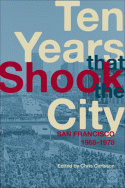 Find the book at City Lights!
Find the book at City Lights!


